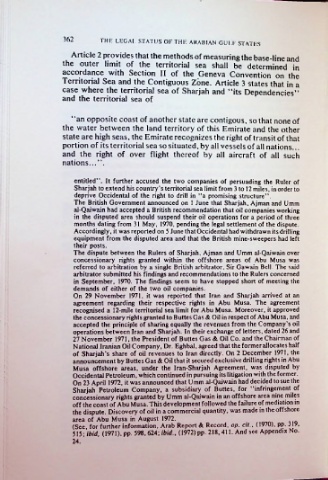Page 428 - The Arabian Gulf States_Neat
P. 428
362 THE LEGAL STATUS OF THE ARABIAN GULF STATES
Article 2 provides that the methods of measuring the base-line and
the outer limit of the territorial sea shall be determined in
accordance with Section II of the Geneva Convention on the
Territorial Sea and the Contiguous Zone. Article 3 states that in a
case where the territorial sea of Sharjah and “its Dependencies”
and the territorial sea of
“an opposite coast of another state are contigous, so that none of
the water between the land territory of this Emirate and the other
state are high seas, the Emirate recognizes the right of transit of that
portion of its territorial sea so situated, by all vessels of all nations,
and the right of over flight thereof by all aircraft of all such
nations...”.
entitled". It further accused the two companies of persuading the Ruler of
Sharjah to extend his country’s territorial sea limit from 3 to 12 miles, in order to
deprive Occidental of the right to drill in "a promising structure".
The British Government announced on 1 June that Sharjah, Ajman and Umm
al-Qaiwain had accepted a British recommendation that oil companies working
in the disputed area should suspend their oil operations for a period of three
months dating from 31 May, 1970, pending the legal settlement of the dispute.
Accordingly, it was reported on 5 June that Occidental had withdrawn its drilling
equipment from the disputed area and that the British mine-sweepers had left
their posts.
The dispute between the Rulers of Sharjah, Ajman and Umm al-Qaiwain over
concessionary rights granted within the offshore areas of Abu Musa was
referred to arbitration by a single British arbitrator. Sir Gawain Bell. The said
arbitrator submitted his findings and recommendations to the Rulers concerned
in September, 1970. The findings seem to have stopped short of meeting the
demands of either of the two oil companies.
On 29 November 1971, it was reported that Iran and Sharjah arrived at an
agreement regarding their respective rights in Abu Musa. The agreement
recognised a 12-mile territorial sea limit for Abu Musa. Moreover, it approved
the concessionary rights granted to Buttes Gas & Oil in respect of Abu Musa, and
accepted the principle of sharing equally the revenues from the Company’s oil
operations between Iran and Sharjah. In their exchange of letters, dated 26 and
27 November 1971, the President of Buttes Gas & Oil Co. and the Chairman of
National Iranian Oil Company, Dr. Eghbal, agreed that the former allocates half
of Sharjah’s share of oil revenues to Iran directly. On 2 December 1971, the
announcement by Buttes Gas & Oil that it secured exclusive drilling rights in Abu
Musa offshore areas, under the Iran-Sharjah Agreement, was disputed by
Occidental Petroleum, which continued in pursuing its litigation with the former.
On 23 April 1972, it was announced that Umm al-Qaiwain had decided to sue the
Sharjah Petroleum Company, a subsidiary of Buttes, for "infringement of
concessionary rights granted by Umm al-Qaiwain in an offshore area nine miles
off the coast of Abu Musa. This development followed the failure of mediation in
the dispute. Discovery of oil in a commercial quantity, was made in the offshore
area of Abu Musa in August 1972.
(See, for further information, Arab Report & Record, op. cit., (1970), pp. 3 y.
515; ibid, (1971), pp. 598, 624; ibid., (1972) pp. 218,411. And see Appendix No.
24.

